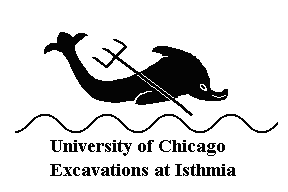UNIVERSITY OF CHICAGO EXCAVATIONS AT ISTHMIA, 2009
GENERAL
The first conference on the archaeology of the Korinthia was organized by the Λ Ζ (37th) Ephoreia of Prehistoric and Classical Antiquities of the Hellenic Ministry of Culture and the ephor, Dr. Konstantinos Kissas and held at Loutraki, 26-29 March. F. Hemans, A. Jackson and E. Gebhard gave papers, and E. Gebhard served on the Scientific Committee. The proceedings are to be published by the German Archaeological Institute in Athens.
Re-mounting of displays and redecoration of the Isthmia Museum has been completed and the museum is open to visitors.
The help and support of Jean Perras and the careful editorial hand of Sara Strack added much to the productivity of the season.
In addition to preparation of manuscripts for the Isthmia monograph series, colleagues reported the following new information concerning their areas.
TEMPLES OF POSEIDON Fritz Hemans
Archaic temple (ca. 680-650 B.C.)
Detailed study of construction debris showed that the blocks were finished at the time they were hoisted into place on the wall.
A block was identified as belonging to a stone floor installed in the pteron at the east end of the building, probably in the second half of the 6th century B.C. A stylobate block, next to it but not in situ, has a cutting on its rear edge for the installation of a floor slab, or some other stone fitting.
Classical Temple (second half of the 5th century, rebuilt in the towards the end of the 4th century B.C.
Examination of materials from construction of the Classical temple and its subsequent rebuilding after a fire in 390 B.C. points to the first building having been almost entirely rebuilt. Earlier fragments were reused wherever possible.
The condition of the temple at the time it was robbed in the 5th century A.D. was clarified. Patterns of stone robbing that had been found during the 1954 excavations but later removed were traced from the excavation notebooks.
TEMPLE OF PALAIMON, Antonine period Fritz Hemans, Elizabeth Gebhard
A stone-for-stone section through the building at 1:20 was prepared by F. Hemans. The entrance to the passage leading to the crypt (adyton) lay at the floor level of the precinct surrounding the temple but no means of entering the passage could be discerned. The vault of the passage would have risen almost 3 m. above the entrance, confirming the high, narrow shape of the opening that is shown on some Corinthian coins of the period.
LATE ARCHAIC AND CLASSICAL CERAMICS Martha Risser; assisted by Courtney Soule and Audrey Blumstein
Two fragments of an Attic lamp belonging to the fourth quarter of the 6th century B.C. previously excavated at opposite ends of the temenos were found to join. The lamp together with other examples of joining fragments of artifacts reveal a pattern of deposition of debris from the Archaic Temple whereby objects stored in the temple at the time of the fire were dispersed to terracing at the northwest and east ends of the temenos.
ARMS AND ARMOR Alastar Jackson
Weapons of Macedonian type from a monument near Isthmia of ca. 350 – 320 B.C., reflected the growing influence of Macedonia in Corinth at the time.
Projectiles were found that could be related to Mummius’ defeat of the Achaean League on the Isthmus in 146 B.C.
RACHI SETTLEMENT Virginia Anderson Stojanović
Study of the terracotta architecture and roof tiles revealed a class of tiles that were manufactured in Corinthian fabric but used Laconian shapes and were comparable to Laconian tiles in size. Since the two systems could not be used together on a single house, it appears that some houses must have had Corinthian roofs, while others used a combination of true Laconian tiles and Corinthian type Laconian for the Laconian-type roof.
WORKED STONE TOOLS Ivan Gatsov, Petranka Nadelzheva.
The archaeological context of tools related to grinding places the activity close to the temple and suggests that food preparation took place in the temenos.
Respectfully submitted,
Elizabeth Gebhard, Director
21 October 2009





